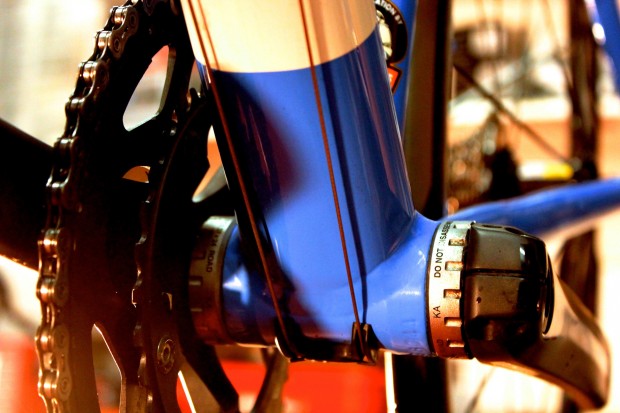Downtube
The downtube, the link between the headtube and bottom bracket, is subject to tremendous forces at either end: the torsion of twisting handlebars at its junction with the headtube, and pedalling forces at the bottom bracket. Like the wheelbase, its length is an outcome, rather than a starting point: the result of the designer’s decisions on the length of headtube, seat-tube, and top-tube.
The downtube on many carbon bikes has become progressively larger in successive years, with those on Trek’s Madone range and from MCipollini among the broadest. “The bigger the volume, the stiffer it is,” Gribaudo explains. “It’s like for alloy: oversized tubes have better stiffness, and most of the time [they’re used] to reduce the weight.”

Gribaudo is at pains to stress, however, that stiffness in a carbon downtube is as much the result of the fibres used and the lay-up as its diameter. Wall thickness, and so weight, results from the designer’s choice of fibre. By using cheaper, 24-tonne fibre – Toray’s T700, for example – the designer can reduce the cost of the frame, but will need to use more layers to achieve the stiffness of other, more expensive fibres. “If you want to be lighter, you can use some 30 tonne, 40 tonne, or 46 tonne fibres, which is more expensive but also stiffer,” he explains, “and then sometimes you can reduce and remove one, two, or three layers to achieve the same stiffness.”
Olsen, who works predominantly with aluminium, concurs, arguing that it is not possible to deduce if a carbon downtube is stiff simply by considering its girth. “If the lay-up’s not right, it could actually be less stiff than a relatively stiff steel frame,” he says.
The diameter of an aluminium downtube has a critical influence on its stiffness, Olsen continues. The Pinnacle bikes he designs for Evans Cycles, he says, are similar in weight to the bikes he designs with Sir Chris Hoy, but not as stiff. While the thickness of the tube walls is similar, the diameter of the downtubes on the Pinnacle bikes is 10 per cent smaller than those on the Hoy bikes. “The diameter makes the difference on stiffness,” he explains. “Wall thickness is more of a fine tune.”
Designers working with steel, however, have not followed the trend for oversized downtubes. The reason? They don’t need to. “Mainly that’s because inherently steel is a very stiff material,” says Steward. “The stiffness to weight ratio and the strength of it means that unlike other metals like Ti and aluminium, you don’t need the same wall thicknesses. Because it’s a much stiffer material, you don’t need the wider diameter in order to get the strength needed.”




